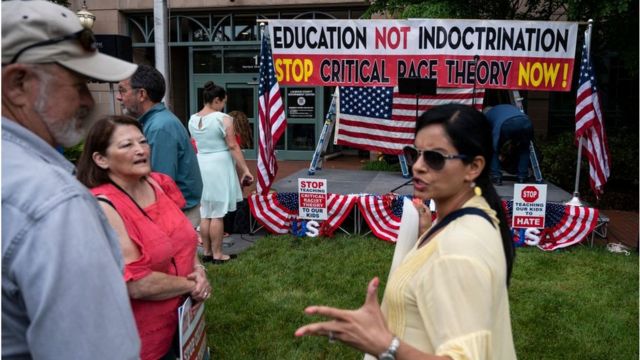(Greg Piper) Pilot study of San Diego County school districts finds many dominated by “underrepresented minorities” eschew these controversial concepts.
Related Facebook Goes Full-on Woke Using Critical Race Theory in New Censorship Policy
by Greg Piper, October 25th, 2021
Aschool district’s racial and ethnic diversity does not reliably predict its affinity for critical race theory (CRT) in the curriculum and diversity, equity and inclusion (DEI) policies, according to research by a group that promotes race-blind policies.
The Californians for Equal Rights Foundation (CFER) studied 42 districts in San Diego County, home to some of the fiercest battles over school racial issues in recent years, and published rankings based on their implementation or prohibition of CRT and DEI. It also studied one in San Luis Obispo County.
Executive Director Wenyuan Wu shared with Just the News underrepresented minority (URM) figures for each district, which aren’t currently part of the interactive chart. The category includes self-identified Hispanics, blacks, Hawaiians and Native Americans, but not Asians.
Several districts with low URM populations are big promoters of CRT and DEI, while several majority-URM districts are not, according to the data, which CFER pulled from school data aggregator Public School Review.
CFER said it expects this “pilot research project,” which reviewed school district websites as well as school board policies, meeting agendas and minutes, to be expanded into a national database. President Frank Xu said it should serve as “a wake-up call for community stakeholders to comprehend the pervasiveness of CRT’s invasion in our public education.”
The nonprofit grew out of the No on 16 campaign, which helped defeat a ballot measure to overturn California’s 25-year-old ban on racial preferences in public institutions such as college admissions. Its vice president is University of San Diego law professor Gail Heriot, a longtime member of the U.S. Commission on Civil Rights.
The research treats DEI and ethnic studies as “intricately interrelated constructs rooted in critical pedagogy or CRT,” and dubs ethnic studies the “paradigmatic vehicle for CRT.” California approved an ethnic studies curriculum for its high schools this spring.
Gov. Gavin Newsom signed legislation earlier this month making one semester of ethnic studies a graduation requirement, the first state in the country to do so, starting with the class of 2030.
Each district is rated on a 5-point scale, with higher scores for districts that eschew CRT and DEI. One point each is given for banning or discouraging the teaching of CRT; not promoting DEI “or its equivalents such as racial equity”; not committing local funding to advancing DEI; not hiring personnel to conduct DEI policy; and not providing an ethnic studies course.
The districts with the lowest scores tend to be in urban and coastal areas, according to CFER. Every San Diego County district has failed to approve a CRT ban, while San Luis Obispo County’s Paso Robles Joint Unified approved a ban in August on five “elements” of CRT and eight doctrines “derived from” it. It’s the only district with a score of five.
More than half of San Diego County districts have a DEI policy and two-thirds have paid DEI training, though less than a third have a DEI department, and fewer than a fifth have “CRT-based ethnic studies.”
Twenty districts have scores from zero — “meaning all-encompassing promotion of DEI and CRT” — to two, CFER said.
In eight of those, URMs are less than half the population: Del Mar Union Elementary (12%), Solana Beach Elementary (14%), San Dieguito Union High (15%), Poway Unified (17%), Encinitas Union Elementary (23%), Coronado Unified (23%), Carlsbad Unified (29%) and Alpine Union Elementary (30%)
Among the 22 districts with scores of three or four, nine have majority-URM populations: Mountain Empire Unified (55%), Jamul-Dulzura Union Elementary (57%), Valley Center-Pauma Unified (64%), Fallbrook Union Elementary (65%), Escondido Union High (66%), Fallbrook Union High (69%), Escondido Union (73%), Borrego Springs Unified (74%), and Vallecitos Elementary (78%).
Fight viruses, remove heavy metals and microplastics, and restore your gut all at once with
Humic and Fulvic Acid from Ascent Nutrition.
MUST HAVE DETOX POWERHOUSE!
Save 10% and get free shipping with a subscription!
About The Author
Greg Piper has covered law and policy for 15 years, with a focus on tech companies, civil liberties and higher education. He joined Just the News from The College Fix, where he trained college students in journalism and covered the biggest controversies on campus, from free speech and academic freedom battles to sexual misconduct proceedings and litigation. His interest in college journalism was prompted by an effort to make a TV pilot about a college newspaper like his own.
Stillness in the Storm Editor: Why did we post this?
The news is important to all people because it is where we come to know new things about the world, which leads to the development of more life goals that lead to life wisdom. The news also serves as a social connection tool, as we tend to relate to those who know about and believe the things we do. With the power of an open truth-seeking mind in hand, the individual can grow wise and the collective can prosper.
– Justin
Not sure how to make sense of this? Want to learn how to discern like a pro? Read this essential guide to discernment, analysis of claims, and understanding the truth in a world of deception: 4 Key Steps of Discernment – Advanced Truth-Seeking Tools.
Stillness in the Storm Editor’s note: Did you find a spelling error or grammatical mistake? Send an email to corrections@stillnessinthestorm.com, with the error and suggested correction, along with the headline and url. Do you think this article needs an update? Or do you just have some feedback? Send us an email at sitsshow@gmail.com. Thank you for reading.
Source:
DIRECT DONATION
Support our work! (Avoid Big Tech PayPal and Patreon)


Leave a Reply